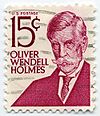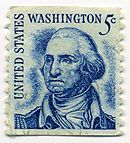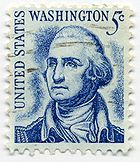
Prominent Americans series
Encyclopedia
 |
|
 |
 |
The Prominent Americans series is a set of definitive stamp
Definitive stamp
A definitive stamp is a postage stamp, that is part of a regular issue of a country's stamps available for sale by the postal service for an extended period of time...
s issued by the United States Post Office Department
United States Post Office Department
The Post Office Department was the name of the United States Postal Service when it was a Cabinet department. It was headed by the Postmaster General....
(and later the United States Postal Service
United States Postal Service
The United States Postal Service is an independent agency of the United States government responsible for providing postal service in the United States...
) between 1965 and 1978.
It superseded the Liberty issue
Liberty Issue
The Liberty issue was a definitive series of postage stamps issued by the United States between 1954 and 1965. It offered twenty-four denominations, ranging from a half-cent issue showing Benjamin Franklin to a five dollar issue depicting Alexander Hamilton...
of 1954, which by the mid-1960s had become somewhat dated, for instance in its focus on political figures. This was the first U. S. omnibus definitive series in which Benjamin Franklin did not appear at or near the beginning: on the ½¢ or 1¢ stamp. The values of the new series included figures from all walks of life, each depicted in a different style by a different designer, presumably in a quest for wide diversity—a significant departure from the uniformity of concept that had marked previous definitive issues. That portraits of two women appear in the series (Elizabeth Blackwell and Lucy Stone) represented a small but significant step toward gender equality in U. S. Stamp history: no previous definitive set had included more than one prominent female (Martha Washington in the issues of 1902, 1922 and 1938; Susan B. Anthony in the Liberty series).
The stamps appeared one by one from 1965 on, and the basic designs had all been issued by 1968; tagged versions made their first appearances gradually through 1973, and coil
Coil stamp
A coil stamp is a type of postage stamp sold in strips one stamp wide. The name derives from the usual handling of long strips, which is to coil them into rolls, in a manner reminiscent of adhesive tape rolls...
and booklet
Postage stamp booklet
A postage stamp booklet is a booklet made up of one or more small panes of postage stamps in a cardboard cover. Booklets are often made from sheets especially printed for this purpose, with a narrow selvedge at one side of the booklet pane for binding. From the cutting, the panes are usually...
version of the 15¢ were issued in 1978 in response to a first-class rate change.
The 5¢ Washington was originally excessively shaded around the lower part of the face, so much so that it has come to be known as the "dirty face" or "unshaven" Washington. Originally appearing in February 1966, it was superseded by a lightened version in November 1967. The $1 Eugene O'Neill
Eugene O'Neill
Eugene Gladstone O'Neill was an American playwright and Nobel laureate in Literature. His poetically titled plays were among the first to introduce into American drama techniques of realism earlier associated with Russian playwright Anton Chekhov, Norwegian playwright Henrik Ibsen, and Swedish...
stamp was made (in)famous by Theodore Kaczynski
Theodore Kaczynski
Theodore John "Ted" Kaczynski , also known as the "Unabomber" , is an American mathematician, social critic, anarcho-primitivist, and Neo-Luddite who engaged in a mail bombing campaign that spanned nearly 20 years, killing three people and injuring 23 others.Kaczynski was born in Chicago, Illinois,...
, who habitually used them on his mail bombs.
Stamps of the series:
- 1¢ green - Thomas JeffersonThomas JeffersonThomas Jefferson was the principal author of the United States Declaration of Independence and the Statute of Virginia for Religious Freedom , the third President of the United States and founder of the University of Virginia...
- 1¼¢ light green - Albert GallatinAlbert GallatinAbraham Alfonse Albert Gallatin was a Swiss-American ethnologist, linguist, politician, diplomat, congressman, and the longest-serving United States Secretary of the Treasury. In 1831, he founded the University of the City of New York...
- 2¢ dark blue gray - Frank Lloyd WrightFrank Lloyd WrightFrank Lloyd Wright was an American architect, interior designer, writer and educator, who designed more than 1,000 structures and completed 500 works. Wright believed in designing structures which were in harmony with humanity and its environment, a philosophy he called organic architecture...
with Guggenheim MuseumSolomon R. Guggenheim MuseumThe Solomon R. Guggenheim Museum is a well-known museum located on the Upper East Side of Manhattan in New York City, United States. It is the permanent home to a renowned collection of Impressionist, Post-Impressionist, early Modern, and contemporary art and also features special exhibitions... - 3¢ violet - Francis ParkmanFrancis ParkmanFrancis Parkman was an American historian, best known as author of The Oregon Trail: Sketches of Prairie and Rocky-Mountain Life and his monumental seven-volume France and England in North America. These works are still valued as history and especially as literature, although the biases of his...
- 4¢ black - Abraham LincolnAbraham LincolnAbraham Lincoln was the 16th President of the United States, serving from March 1861 until his assassination in April 1865. He successfully led his country through a great constitutional, military and moral crisis – the American Civil War – preserving the Union, while ending slavery, and...
- 5¢ blue - George WashingtonGeorge WashingtonGeorge Washington was the dominant military and political leader of the new United States of America from 1775 to 1799. He led the American victory over Great Britain in the American Revolutionary War as commander-in-chief of the Continental Army from 1775 to 1783, and presided over the writing of...
- 6¢ gray brown - Franklin Delano Roosevelt
- 8¢ violet - Albert EinsteinAlbert EinsteinAlbert Einstein was a German-born theoretical physicist who developed the theory of general relativity, effecting a revolution in physics. For this achievement, Einstein is often regarded as the father of modern physics and one of the most prolific intellects in human history...
- 10¢ lilac - Andrew JacksonAndrew JacksonAndrew Jackson was the seventh President of the United States . Based in frontier Tennessee, Jackson was a politician and army general who defeated the Creek Indians at the Battle of Horseshoe Bend , and the British at the Battle of New Orleans...
- 12¢ black - Henry FordHenry FordHenry Ford was an American industrialist, the founder of the Ford Motor Company, and sponsor of the development of the assembly line technique of mass production. His introduction of the Model T automobile revolutionized transportation and American industry...
with Model T - 13¢ brown - John F. KennedyJohn F. KennedyJohn Fitzgerald "Jack" Kennedy , often referred to by his initials JFK, was the 35th President of the United States, serving from 1961 until his assassination in 1963....
- 15¢ claret - Oliver Wendell Holmes, Jr.Oliver Wendell Holmes, Jr.Oliver Wendell Holmes, Jr. was an American jurist who served as an Associate Justice of the Supreme Court of the United States from 1902 to 1932...
- 16¢ light brown - Ernie PyleErnie PyleErnest Taylor Pyle was an American journalist who wrote as a roving correspondent for the Scripps Howard newspaper chain from 1935 until his death in combat during World War II. He won the Pulitzer Prize in 1944...
- 18¢ purple - Elizabeth BlackwellElizabeth BlackwellElizabeth Blackwell was the first female doctor in the United States and the first on the UK Medical Register...
- 20¢ olive - George C. Marshall
- 25¢ lake - Frederick DouglassFrederick DouglassFrederick Douglass was an American social reformer, orator, writer and statesman. After escaping from slavery, he became a leader of the abolitionist movement, gaining note for his dazzling oratory and incisive antislavery writing...
- 30¢ reddish lilac - John DeweyJohn DeweyJohn Dewey was an American philosopher, psychologist and educational reformer whose ideas have been influential in education and social reform. Dewey was an important early developer of the philosophy of pragmatism and one of the founders of functional psychology...
- 40¢ bluish black - Thomas PaineThomas PaineThomas "Tom" Paine was an English author, pamphleteer, radical, inventor, intellectual, revolutionary, and one of the Founding Fathers of the United States...
- 50¢ magenta - Lucy StoneLucy StoneLucy Stone was a prominent American abolitionist and suffragist, and a vocal advocate and organizer promoting rights for women. In 1847, Stone was the first woman from Massachusetts to earn a college degree. She spoke out for women's rights and against slavery at a time when women were discouraged...
- $1 dull purple - Eugene O'NeillEugene O'NeillEugene Gladstone O'Neill was an American playwright and Nobel laureate in Literature. His poetically titled plays were among the first to introduce into American drama techniques of realism earlier associated with Russian playwright Anton Chekhov, Norwegian playwright Henrik Ibsen, and Swedish...
- $5 gray black - John Bassett MooreJohn Bassett MooreJohn Bassett Moore was an American authority on international law who was a member of the Hague Tribunal and the first US judge to serve on the Permanent Court of International Justice ....
A number of later stamps, issued between 1970 and 1974 are sometimes considered part of the series; they have similarities of style, and are mostly in denominations between the original series:
- 6¢ dark blue gray - Dwight Eisenhower
- 7¢ bright blue - Benjamin FranklinBenjamin FranklinDr. Benjamin Franklin was one of the Founding Fathers of the United States. A noted polymath, Franklin was a leading author, printer, political theorist, politician, postmaster, scientist, musician, inventor, satirist, civic activist, statesman, and diplomat...
- 8¢ blk, red and blue gray or claret - Dwight Eisenhower
- 14¢ gray brown - Fiorello La Guardia
- 16¢ brown - Ernie PyleErnie PyleErnest Taylor Pyle was an American journalist who wrote as a roving correspondent for the Scripps Howard newspaper chain from 1935 until his death in combat during World War II. He won the Pulitzer Prize in 1944...
- 18¢ violet - Elizabeth Blackwell
- 21¢ green - Amadeo GianniniAmadeo GianniniAmadeo Pietro Giannini, also known as Amadeo Peter Giannini or A.P. Giannini , born in San Jose, California, was the American founder of Bank of America.-Biography:...
See also
- Postage stamps and postal history of the United States

